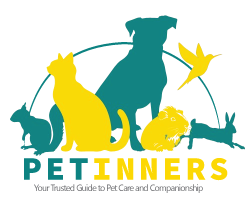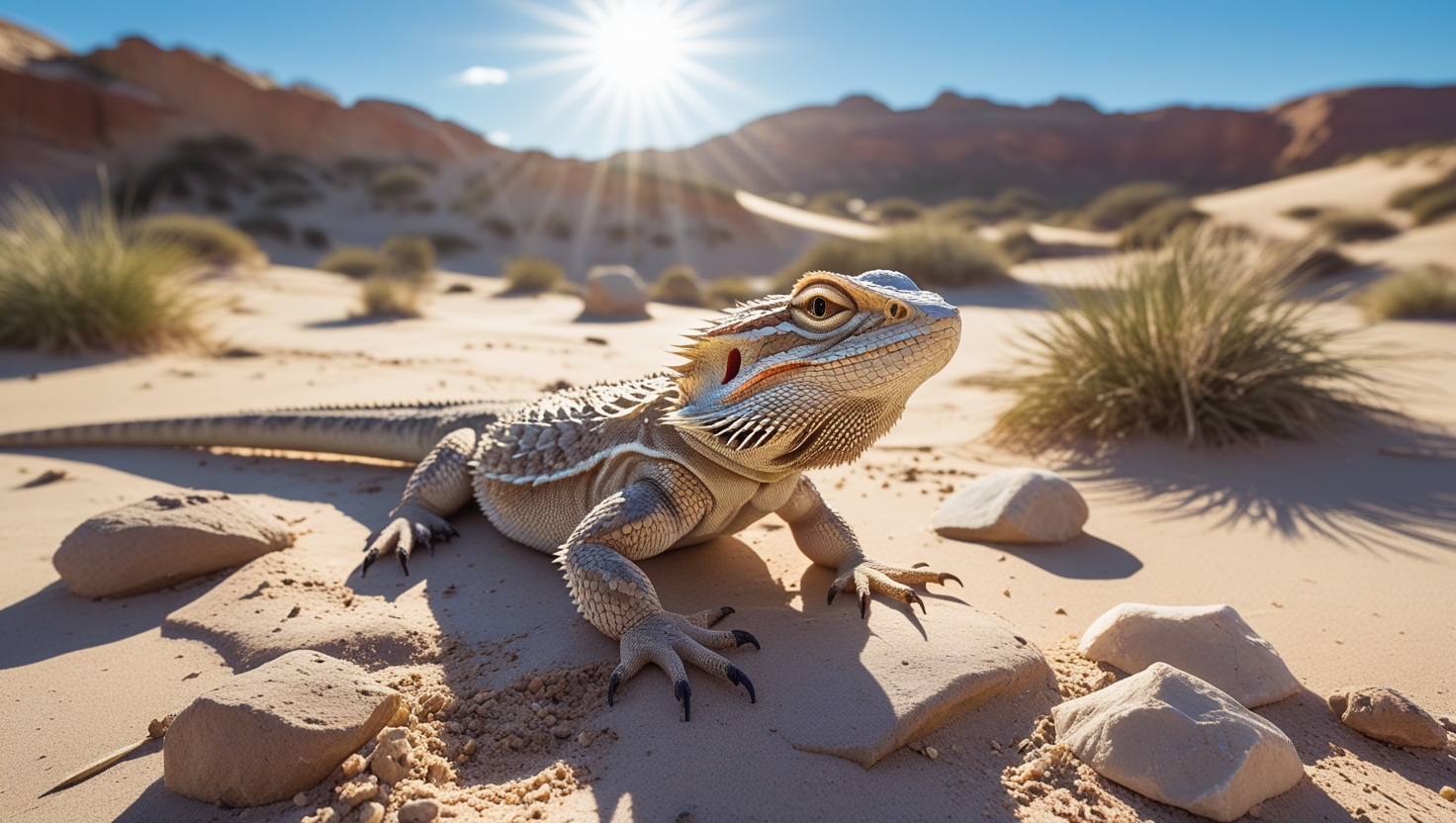Bearded dragon habitat

Bearded dragons are native to Australia’s arid and semi-arid regions, thriving in savannahs, woodlands, and deserts. In captivity, they need a spacious tank (40-120 gallons for adults) with a temperature gradient (100°F warm, 75°F cool), UVB lighting, and low humidity. Safe substrates like slate tile or reptile carpet are ideal. Provide basking spots, hides, and accessories like hammocks to enrich their habitat. A secure, ventilated screen lid helps maintain optimal conditions.
Bearded Dragon Natural Habitat & Ecology
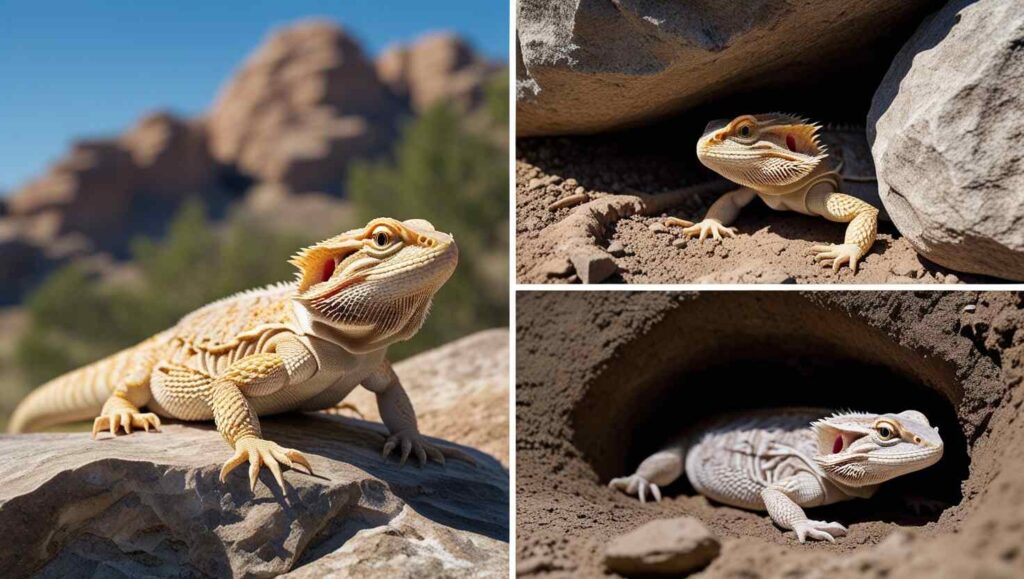
Bearded dragons are endemic to Australia and found across Queensland, New South Wales, Victoria, and Western Australia. These omnivorous reptiles live in sandy, semi-arid, and arid regions such as savannahs, woodlands, deserts, and coastal dunes. Let’s explore the key aspects of their habitat and survival strategies.
Adaptations to Harsh Environments
Bearded dragons have evolved to survive in extreme conditions:
- Basking under the sun to regulate body temperature.
- Entering a torpor state during cooler seasons to conserve energy.
- Utilizing burrows or sheltering under boulders and trees for protection from drought and heat.
Defense Mechanisms and Predation
In the wild, bearded dragons face numerous predators, including:
- Foxes, goannas, and serpents.
- Birds of prey and feral animals.
To defend themselves, they:
- Puff up their beard, creating an intimidating display.
- Adopt a defensive stance, raising their body and flaring their scales.
- Display bobbing heads or waving arms to warn or communicate with rivals.
Habitat Preferences
These generalist creatures are adaptable and thrive in various habitats:
- Sandy dunes, savannahs, and woodlands.
- Areas with fence posts, branches, and barren rocks for basking and territorial observation.
- Sheltered sites for burrowing, often near vegetation or ground cover.
Diet and Feeding Habits
Bearded dragons are omnivorous, feeding on both plant and animal sources:
- Insects, invertebrates, and smaller vertebrates.
- Fruit, flowers, and seasonal vegetation.
Their feeding strategy involves efficient energy use, especially during drought or scarce seasons.
Reproduction and Burrowing
Females lay their clutches of eggs in protected burrows, which are:
- Carefully chosen to provide stable thermal conditions.
- Incubated naturally with warmth from the ground.
This process ensures that the young develop in safety, despite external threats from predators.
Human Impact and Adaptability
The expansion of urbanised areas and agriculture has led to habitat loss and environmental degradation. However, bearded dragons have shown remarkable adaptability:
- They are often found near farms, fence lines, and coastal sites.
- They thrive despite encounters with pests, feral animals, and seasonal challenges.
Personal Observations
During my explorations, I’ve seen bearded dragons in action:
- A cheeky dragon exploring boulders and woodlands, confidently strutting.
- They display a mix of gentle, calmer moments and defensive actions when startled.
These reptiles are not only impressive survivors but also showcase curious, social behavior that captivates researchers and wildlife enthusiasts alike.
Bearded Dragon Tank Setup
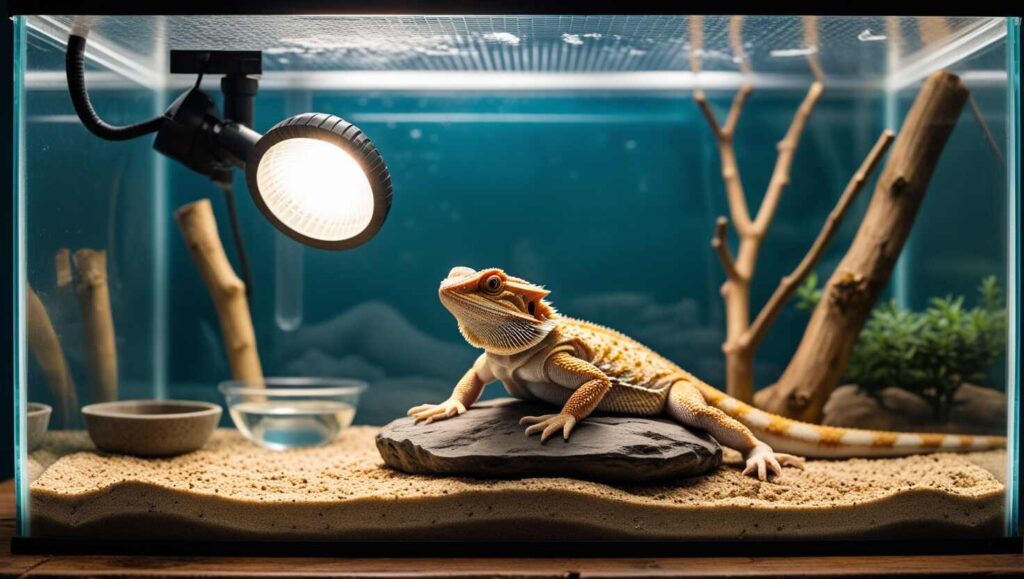
Types of Tank and Covers
There are different types of tanks you can use for your bearded dragon. Below is an overview of enclosures commonly used by reptile owners.
Glass Aquariums
These are probably the most popular type of enclosure and can be found at any local pet store. They are inexpensive and often great for other reptiles too. However, glass tanks are heavy, which means once the tank is setup, you likely won’t want to move it again. They also don’t hold heat well, which could cause your dragon’s color to look dull if the tank is not warm enough.
Melamine Cages
These cages are made from melamine board, a material available at most hardware stores. You can build them yourself or buy them online. Owners love the look of these tanks because the white boards reflect extra light, which can make dragons happier. However, these enclosures can be fairly expensive and difficult to move due to their weight.
PVC and ABS Plastic Tanks
Plastic tanks, like PVC or ABS, are very lightweight and sturdy, making them easier to move and stack. They also don’t produce odor, which many enthusiasts prefer. Some brands, like Vision or NPI, offer professional designs with chemical-resistant surfaces and built-in lamp shrouds for easy cleaning. These are popular with breeders who stack multiple tanks to save space.
Tank Covers
A lid or cover is necessary to prevent your beardie from escaping. Since bearded dragons come from dry desert areas with low humidity, avoid using solid lids. Plastic covers may increase humidity to unhealthy levels. The best option is a screen lid that allows fresh air circulation while also supporting the weight of lights and lamps. This setup helps maintain a healthy environment for your dragon.
Tank Size
You need to make sure you have the right size tank for your bearded dragon. A tank that is too small can cause stress and limit their growth. Follow these guidelines to find the best fit for your dragon.
- Baby dragons (10–16 inches) do well in a 20-gallon tank. This gives them space to move and easily catch food.
- Early adult dragons (16–20 inches) require at least a 40-gallon tank. A larger tank makes them happier and promotes better growth.
- Fully grown dragons, 20+ inches, need a minimum of 75 gallons, but 120 gallons is ideal for maximum comfort.
If you’ve forgotten how many gallons your tank holds, use a simple calculator to check the tank’s dimensions.
Temperature, Lighting, and Humidity
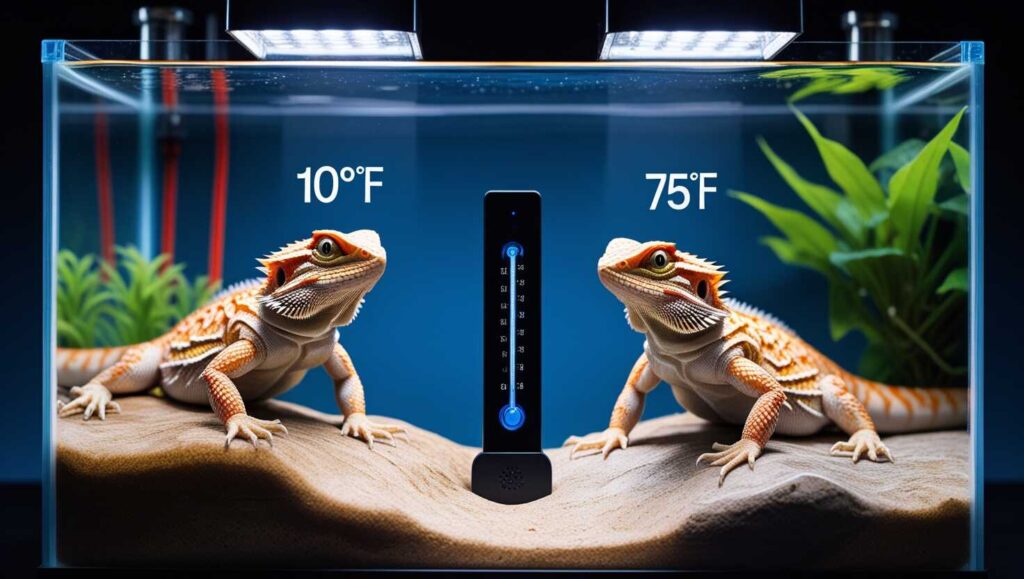
Bearded dragons need a thermal gradient in their enclosure to regulate body temperature. The warm area of the tank should be around 100°F, while the cooler side stays at 75°F.
Check temperatures daily. Use two thermometers—one on each end of the tank—to monitor both zones. A digital or point-and-shoot thermometer can also be used for quick readings. Maintaining this balance keeps your dragon’s habitat safe and healthy.
Tank Bedding and Substrate
You will need proper flooring for your dragon’s tank. The type of bedding depends on the age of your bearded dragon.
For younger dragons, use newspaper, paper towels, butcher paper, or reptile carpet. These options are recommended because they are safe and easy to clean. Avoid anything loose, as young dragons might accidentally swallow bits of it while catching prey, which can be harmful.
Tank Decoration and Accessories
You can’t expect your bearded dragon to be happy in a bare tank. Get creative with accessories to provide enrichment and allow your dragon to thrive.
Include reptile hammocks, which dragons love. Use suction cups or hooks to attach them. Add semi-arboreal perches, like branches and basking platforms, along the tank’s length.
Use rough rocks or wood to help keep claws trimmed. Add hiding areas using logs or traditional hides. A shallow water dish on the cool side helps with hydration.
Summary
Only one male bearded dragon should be housed in an enclosure to prevent aggression. Female dragons may live together but should be monitored to ensure they are compatible.
Provide a 40-gallon tank for an adult, with heating, a basking bulb, and a UVB light. Use a safe substrate, like slate tile, and add plenty of decor. A water bowl and food dish complete the setup to keep your pet happy and healthy.
Kindly note: The content shared in this blog is gathered from online sources, some of which may not be verified. For accurate guidance on caring for your Bearded dragons, it is recommended to seek advice from a qualified veterinarian.
